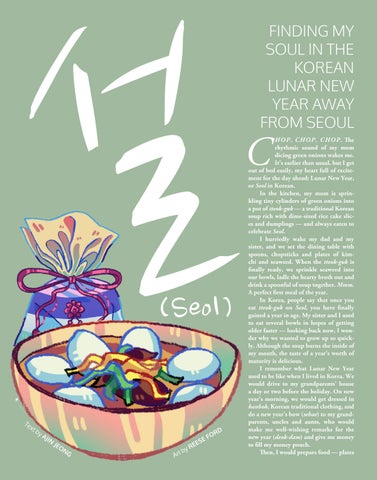설
FINDING MY SOUL IN THE KOREAN LUNAR NEW YEAR AWAY FROM SEOUL
C
(Seol)
Te
xt
by
AJ
IN
JE
ON
G
48 FEBRUARY 2022
A
y rt b
D OR
E RE
F SE
H O P . C H O P . C H O P . The rhythmic sound of my mom dicing green onions wakes me. It’s earlier than usual, but I get out of bed easily, my heart full of excitement for the day ahead: Lunar New Year, or Seol in Korean. In the kitchen, my mom is sprinkling tiny cylinders of green onions into a pot of tteok-guk — a traditional Korean soup rich with dime-sized rice cake slices and dumplings — and always eaten to celebrate Seol. I hurriedly wake my dad and my sister, and we set the dining table with spoons, chopsticks and plates of kimchi and seaweed. When the tteok-guk is finally ready, we sprinkle seaweed into our bowls, ladle the hearty broth out and drink a spoonful of soup together. Mmm. A perfect first meal of the year. In Korea, people say that once you eat tteok-guk on Seol, you have finally gained a year in age. My sister and I used to eat several bowls in hopes of getting older faster — looking back now, I wonder why we wanted to grow up so quickly. Although the soup burns the inside of my mouth, the taste of a year’s worth of maturity is delicious. I remember what Lunar New Year used to be like when I lived in Korea. We would drive to my grandparents’ house a day or two before the holiday. On new year’s morning, we would get dressed in hanbok, Korean traditional clothing, and do a new year’s bow (sebae) to my grandparents, uncles and aunts, who would make me well-wishing remarks for the new year (deok-dam) and give me money to fill my money pouch. Then, I would prepare food — plates








